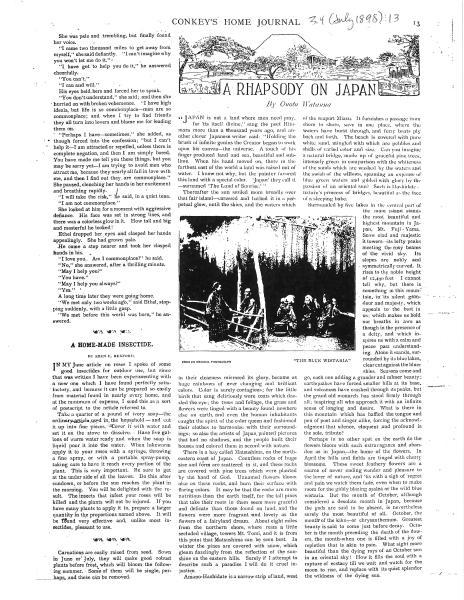“Japan is not a land where men need pray, for ‘tis itself divine,” sang the poet Hitomara more than a thousand years ago, and another clever Japanese writer said: “Holding the brush of infinite genius the Creator began to work upon his canvas—the universe. A touch of his finger produced land and sea, beautiful and sublime. When his hand moved on, there in the farthest east of the world a land was raised out of water. I know not why, but the painter favored this land with a special color. ‘Japan’ they call it—surnamed ‘The Land of Sunrise.’”
Thereafter, the sun smiled more broadly over that fair island—caressed and bathed it in a perpetual glow, until the skies, and the waters which in their clearness mirrored its glory, became as huge rainbows of ever changing and brilliant colors. Color is surely contagious; for the little birds that sang deliriously wore coats which dazzled the eye; the trees and foliage, the grass and flowers were tinged with a beauty found nowhere else on earth, and even the human inhabitants caught the spirit of the color queen and fashioned their clothes to harmonize with their surroundings; so also the artists of Japan painted pictures that had no shadows, and the people built their houses and colored them in accord with nature.
There is a bay called Matsushima, on the northeastern coast of Japan. Countless rocks of huge size and form are scattered in it, and these rocks are covered with pine trees which were planted by the hand of God. Unnamed flowers bloom also on these rocks, and burn their surface with flaring colors. It may be that the rocks are more nutritious than the earth itself, for the tall pines that take their roots in them seem more graceful and delicate than those found on land, and the flowers were more fragrant and lovely as the flowers of a fairyland dream. About eight miles from the northern shore, where rests a little secluded village, towers Mt. Tomi, and it is from this point that Matsushima can be seen best. In winter the pines are covered with snow, which gleam dazzlingly from the reflection of the sunshine on the eastern hills. Surely if I attempt to describe such a paradise I will do it cruel injustice.
Amano-Hashidate is a narrow strip of land, west of the seaport Miazu. It furnishes a passage from shore to shore, save in one place, where the waters have burst through, and ferry boats ply back and forth. The beach is covered with pure white sand, mingled with which are pebbles and shells of varied color and size. Can you imagine a natural bridge, made up of graceful pine trees, intensely green in comparison with the whiteness of the sands which are washed by the waters and the swish of the willows, spanning an expanse of blue green waters and gilded with glory by the passion of an oriental sun? Such is Hashidate—nature’s princess of bridges, beautiful as the face of a sleeping babe.
Surrounded by five lakes in the central part of the main island stands the most beautiful and highest mountain in Japan, Mt. Fuji-Yama. Snow clad and majestic it towers—its lofty peaks meeting the rosy beams of the vivid sky. Its slopes are nobly and symmetrically curved. It rises to the noble height of 12,490 feet. I cannot tell why, but there is something in this mountain, in its silent grandeur and majesty, which appeals to the best in us; which makes us hold our breaths in awe as though in the presence of a deity, and which inspires us with a calm and peace past understanding. Alone it stands, surrounded by its blue lakes, clear-cut against the bluer skies. Seasons come and go, each one adding a grander and calmer beauty; earthquakes have forced smaller hills at its base, and volcanoes have crashed through its peaks, but the grand old monarch has stood firmly through all; inspiring all who approach it with an infinite sense of longing and desire. What is there in this mountain which has baffled the tongue and pen of poet and singer alike, forcing the acknowledgment that silence, eloquent and profound, is the sole tribute?
Perhaps in no other spot on the earth do the flowers bloom with such extravagance and abandon as in Japan—the home of the flowers. In April the hills and fields are tinged with cherry blossoms. These sweet, feathery flowers are a source of never ending wonder and pleasure to the lover of nature, and ‘tis with a sigh of regret and pain we watch them fade, even when to make room for the giddy blazing azalea or the wild blue wistaria. But the month of October, although considered a desolate month in Japan, because the gods are said to be absent, is nevertheless surely the most beautiful of all. October, the month of the kiku—or chrysanthemum. Greatest beauty is said to come just before decay. October is the month preceding the death of the flowers, the month when one is filled with a joy of repletion that is akin to pain. What sight more beautiful than the dying rays of an October sun in an oriental sky! How it fills the soul with a rapture of ecstasy till we wait and watch for the moon to rise, and replace with its quiet splendor the wildness of the dying sun.
